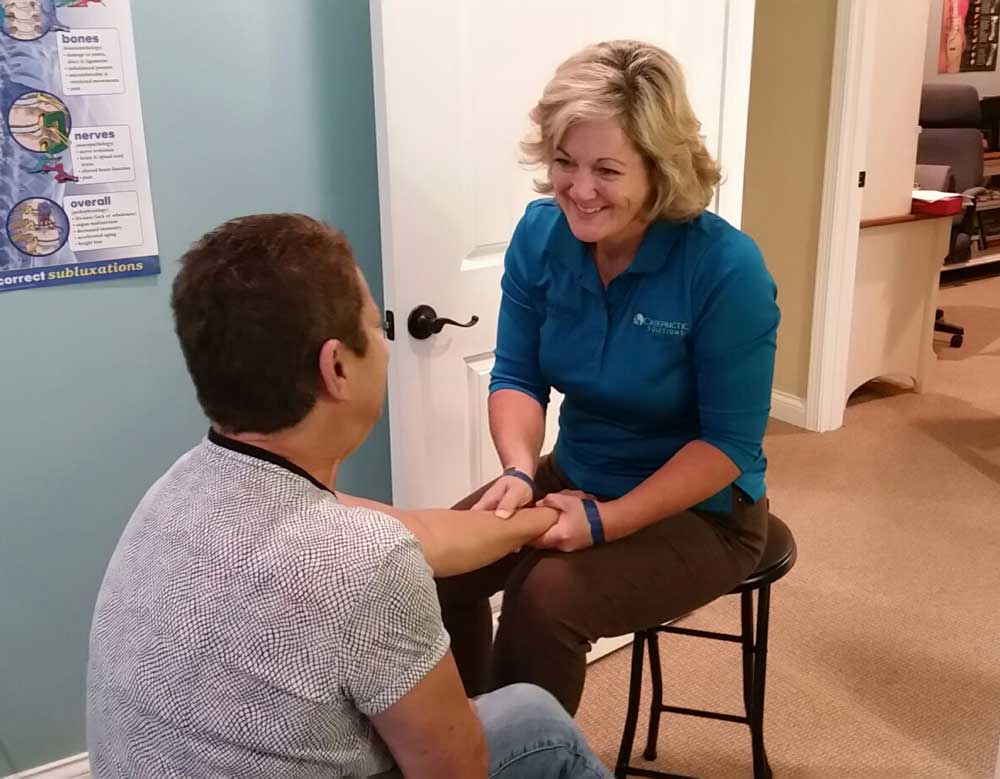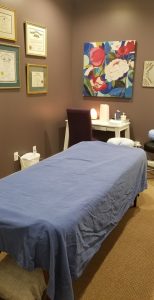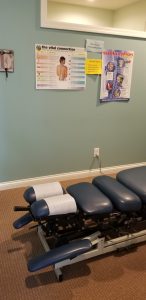
CHIROPRACTIC SOLUTIONS by dr julie
As chiropractors, we specialize in the treatment of neuromusculoskeletal injuries. What does that mean? We treat injuries that involve the soft tissues (connective fascia, muscles, tendons, ligaments and nerves), in addition to joint related injuries. These injuries occur when the load or stress on a tissue exceeds the capacity of the tissue. This load, stress or force can be acute or sudden in the case of a fall or quick movement, or subtle and over a long period of time, which we refer to as chronic over use injuries. An example of a chronic over use injury would be in the case of postural stress, such as sitting for prolonged periods of time, or a repetitive task that injures the tissues over a period of time, such as typing.
 Non-Drug Healthcare. We need it more than ever. The human form was meant to be well, not sick. The body was created to brilliantly adapt, but when stressed beyond its limits, it needs help. Chiropractic Care, in 1895, was established to support that premise when the first defined Chiropractic adjustment was delivered. When you review history, you will see that structural correction was acknowledged by Hippocrates!
Non-Drug Healthcare. We need it more than ever. The human form was meant to be well, not sick. The body was created to brilliantly adapt, but when stressed beyond its limits, it needs help. Chiropractic Care, in 1895, was established to support that premise when the first defined Chiropractic adjustment was delivered. When you review history, you will see that structural correction was acknowledged by Hippocrates!
Long misunderstood, Chiropractic is a highly skilled manual therapy that restores structure to its highest level of function after thorough assessment and analysis. Each Chiropractor has a different level of skill and experience, but practices under the same belief that, in the right conditions, the body has an innate ability to heal. We are Spine Specialists. We understand that a healthy spine supports the muscles, tendons, ligaments, discs that allow for mobility, while housing the vital organs and protecting the nervous system. WOW! There are many signs and symptoms that your body has passed its ability to adapt and has slipped into a state of dysfunction or disease such pain, weakness, numbness, fatigue, decreased mobility, predisposed to injury, organ disease, and mental instability. To maintain anything, you have to consistently “undo” the regular wear and tear through daily use. Your spine is no different. That’s where making Chiropractic Check-ups a regular part of your life makes sense. Today, technology posture and electronic use, poor nutrition, sedentary lifestyle, and dysfunctional family dynamics have stressed the human form way beyond adaptation and so many need help, but don’t know where to start. Well, we have your “SOLUTIONS!” Why choose us?
Dr. Julie has been providing chiropractic care for over 20 years; and has established herself as a unique practitioner in Louisville. She is noted for taking extra time with her patients, utilizing modern chiropractic techniques, advanced extremity care and a variety of specialized treatments to provide you with pain-free living each day. We look forward to helping you with your health care needs.
Dr. Julie is a proud graduate of Life University www.life.edu where she also served as a Clinician from 2002-2004, teaching hundreds of future Chiropractors Adjusting Technique and Case Management. She then was asked to serve as the Clinical Director during an intense period of growth and change in the University from 2004-2006 before moving to Louisville. Founded in 1974, Life University has a long history of being recognized nationally for its innovative chiropractic program and commitment to providing a high-quality undergraduate and graduate education. Life University has the distinction of being Georgia’s only highly selective chiropractic college and boasts superior programs in the fields of biology, biopsychology, business administration, computer information management, dietetics, life coaching, nutrition, psychology, and sport health science.
At Chiropractic Solutions by Dr. Julie, WE ARE COMMITTED TO:
*Providing individualized care.
*Ensuring that patients understand their need for Chiropractic Care.
*Helping patients make informed decisions through each phase of care.
*Supporting patients and their families in the Chiropractic Lifestyle.
*Respecting everyone’s time and money.
All under one roof, we provide: Chiropractic Spinal Adjustments, Chiropractic Extremity Adjustments (a rare specialty), Physical Therapy including Pain and Inflammation Relief with Ultrasound, Interferential Stimulation, Intersegmental Traction, Ice/Heat Rehabilitative Exercises, Therapeutic and Relaxation Massage, Dry Needling and Manual Therapy, Postural Stretching, Strengthening, and Stabilization, Balance and Coordination Therapy, Nutrition Consultation, Exercise Consultation, Brain Balance Therapy, and Nutritional Supplementation
CONDITIONS:
Did you know that patients with headaches, migraine headaches, sinus headaches, TMJ, neck pain, neck tension, neck stiffness, upper back pain, shoulder pain, arm pain, elbow pain, wrist pain, carpal tunnel syndrome, mid back pain, weak core, low back pain, slipped disc, pinched nerve, nerve entrapment, sciatica, hip pain, iliotibial band syndrome (ITB), knee pain, foot & ankle pain, heel spurs, plantar fasciitis, sinusitis, earache, allergies, asthma, indigestion, ADD, ADHD, TBI, mood disorders, anxiety, depression, poor immunity, fibromyalgia, chronic fatigue syndrome, stress, numbness, paresthesia, and neuropathy come to our office for help? What are you waiting for?
RESEARCH:
Still not sure? Check out the most current RESEARCH—Dr. Julie has been a long-time member of the American Chiropractic Association (link) and has provided their most current research articles, supporting the use of Chiropractic as a safe, first choice of care before drugs, injections, and surgery
ACUTE/CHRONIC PAIN:
“Given that most patients with acute or subacute low back pain improve over time regardless of treatment, clinicians and patients should select nonpharmacologic treatment with superficial heat (moderate-quality evidence), massage, acupuncture, or spinal manipulation (low-quality evidence). If pharmacologic treatment is desired, clinicians and patients should select nonsteroidal anti-inflammatory drugs or skeletal muscle relaxants (moderate-quality evidence).”

NONINVASIVE TREATMENT FIRST
“For patients with chronic low back pain, clinicians and patients should initially select nonpharmacologic treatment with exercise, multidisciplinary rehabilitation, acupuncture, mindfulness-based stress reduction (moderate-quality evidence), tai chi, yoga, motor control exercise, progressive relaxation, electromyography biofeedback, low-level laser therapy, operant therapy, cognitive behavioral therapy, or spinal manipulation (low-quality evidence).” Noninvasive Treatments for Acute, Subacute, and Chronic Low Back Pain: A Clinical Practice Guideline From the American College of Physicians (2017) “Many treatments are available for low back pain. Often exercises and physical therapy can help. Some people benefit from chiropractic therapy or acupuncture.” Goodman et al. (2013), Journal of the American Medical Association “[Chiropractic Manipulative Therapy] in conjunction with [standard medical care] offers a significant advantage for decreasing pain and improving physical functioning when compared with only standard care, for men and women between 18 and 35 years of age with acute low back pain.” Goertz et al. (2013), Spine In a Randomized controlled trial, 183 patients with neck pain were randomly allocated to manual therapy (spinal mobilization), physiotherapy (mainly exercise) or general practitioner care (counseling, education and drugs) in a 52-week study. The clinical outcomes measures showed that manual therapy resulted in faster recovery than physiotherapy and general practitioner care. Moreover, total costs of the manual therapy-treated patients were about one-third of the costs of physiotherapy or general practitioner care. Korthals-de Bos et al (2003), British Medical Journal “Patients with chronic low-back pain treated by chiropractors showed greater improvement and satisfaction at one month than patients treated by family physicians. Satisfaction scores were higher for chiropractic patients. A higher proportion of chiropractic patients (56 percent vs. 13 percent) reported that their low-back pain was better or much better, whereas nearly one-third of medical patients reported their low-back pain was worse or much worse.” Nyiendo et al (2000), Journal of Manipulative and Physiological Therapeutics
COMPARISON TO OTHER TREATMENTS:
“Manual-thrust manipulation provides greater short-term reductions in self-reported disability and pain compared with usual medical care. 94% of the manual-thrust manipulation group achieved greater than 30% reduction in pain compared with 69% of usual medical care.” Schneider et al (2015), Spine “Reduced odds of surgery were observed for…those whose first provider was a chiropractor. 42.7% of workers [with back injuries] who first saw a surgeon had surgery, in contrast to only 1.5% of those who saw a chiropractor.” Keeney et al (2012), Spine “Acute and chronic chiropractic patients experienced better outcomes in pain, functional disability, and patient satisfaction; clinically important differences in pain and disability improvement were found for chronic patients.” Haas et al (2005), Journal of Manipulative and Physiological Therapeutics “In our randomized, controlled trial, we compared the effectiveness of manual therapy, physical therapy, and continued care by a general practitioner in patients with nonspecific neck pain. The success rate at seven weeks was twice as high for the manual therapy group (68.3 percent) as for the continued care group (general practitioner). Manual therapy scored better than physical therapy on all outcome measures. Patients receiving manual therapy had fewer absences from work than patients receiving physical therapy or continued care, and manual therapy and physical therapy each resulted in statistically significant less analgesic use than continued care.” Hoving et al (2002), Annals of Internal Medicine
HEADACHES:
“Cervical spine manipulation was associated with significant improvement in headache outcomes in trials involving patients with neck pain and/or neck dysfunction and headache.” McCrory, Penzlen, Hasselblad, Gray (2001), Duke Evidence Report “The results of this study show that spinal manipulative therapy is an effective treatment for tension headaches. . . Four weeks after cessation of treatment . . . the patients who received spinal manipulative therapy experienced a sustained therapeutic benefit in all major outcomes in contrast to the patients that received amitriptyline therapy, who reverted to baseline values.” Boline et al. (1995), Journal of Manipulative and Physiological Therapeutics
NECK PAIN:
In a study funded by NIH’s National Center for Complementary and Alternative Medicine to test the effectiveness of different approaches for treating mechanical neck pain, 272 participants were divided into three groups that received either spinal manipulative therapy (SMT) from a doctor of chiropractic (DC), pain medication (over- the-counter pain relievers, narcotics and muscle relaxants) or exercise recommendations. After 12 weeks, about 57 percent of those who met with DCs and 48 percent who exercised reported at least a 75 percent reduction in pain, compared to 33 percent of the people in the medication group. After one year, approximately 53 percent of the drug-free groups continued to report at least a 75 percent reduction in pain; compared to just 38 percent pain reduction among those who took medication. Bronfort et al. (2012), Annals of Internal Medicine
COST EFFECTIVENESS:
Findings from a study utilizing data from the North Carolina State Health Plan collected between 2000-2009 show that care by a doctor of chiropractic (DC) alone or DC care in conjunction with care by a medical doctor (MD) incurred “appreciably fewer charges” for uncomplicated lower back pain than MD care with or without care by a physical therapist. Hurwitz et al. (2016), Journal of Manipulative and Physiological Therapeutics Older Medicare patients with chronic low back pain and other medical problems who received spinal manipulation from a chiropractic physician had lower costs of care and shorter episodes of back pain than patients in other treatment groups. Patients who received a combination of chiropractic and medical care had the next lowest Medicare costs, and patients who received medical care only incurred the highest costs. Weeks et al (2016), Journal of Manipulative and Physiological Therapeutics Low back pain initiated with a doctor of chiropractic (DC) saves 20 to 40 percent on health care costs when compared with care initiated through a medical doctor (MD), according to a study that analyzed data from 85,000 Blue Cross Blue Shield (BCBS) beneficiaries in Tennessee over a two-year span. The study population had open access to MDs and DCs through self-referral, and there were no limits applied to the number of MD/DC visits allowed and no differences in co-pays. Researchers estimated that allowing DC-initiated episodes of care would have led to an annual cost savings of $2.3 million for BCBS of Tennessee. They also concluded that insurance companies that restrict access to chiropractic care for low back pain treatment may inadvertently pay more for care than they would if they removed such restrictions. Liliedahl et al (2010), Journal of Manipulative and Physiological Therapeutics “Chiropractic care appeared relatively cost-effective for the treatment of chronic low-back pain. Chiropractic and medical care performed comparably for acute patients. Practice-based clinical outcomes were consistent with systematic reviews of spinal manipulative efficacy: manipulation-based therapy is at least as good as and, in some cases, better than other therapeusis.” Haas et al (2005), Journal of Manipulative and Physiological Therapeutics
PATIENT SATISFACTION:
“Chiropractic patients were found to be more satisfied with their back care providers after four weeks of treatment than were medical patients. Results from observational studies suggested that back pain patients are more satisfied with chiropractic care than with medical care. Additionally, studies conclude that patients are more satisfied with chiropractic care than they were with physical therapy after six weeks.” Hertzman-Miller et al (2002), American Journal of Public Health
WIDESPREAD USE OF CHIROPRACTIC:
“Chiropractic is the largest, most regulated, and best recognized of the complementary and alternative medicine (CAM) professions. CAM patient surveys show that chiropractors are used more often than any other alternative provider group and patient satisfaction with chiropractic care is very high. There is steadily increasing patient use of chiropractic in the United States, which has tripled in the pasttwo decades.” Meeker, Haldeman (2002), Annals of Internal Medicine
You Have Questions. We Have Answers
Relief From Your Pain Is One Phone Call Away
Phone: 502.253.1135 | Fax: 502.253.1136
Email: Staff@askdoctorjulie.net

